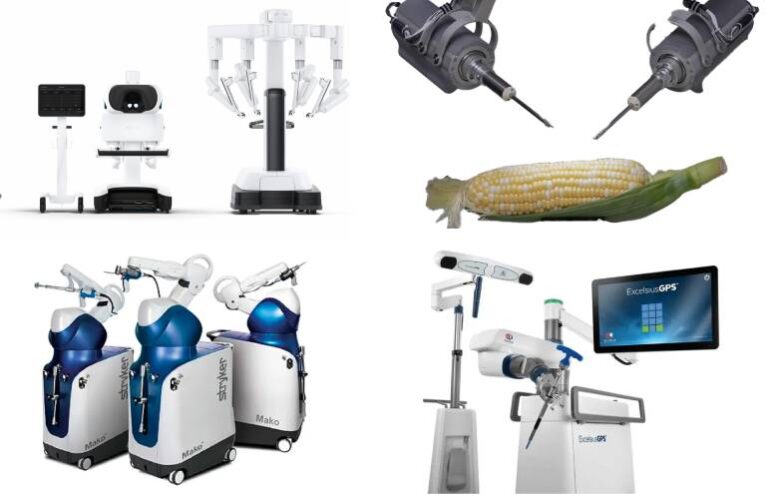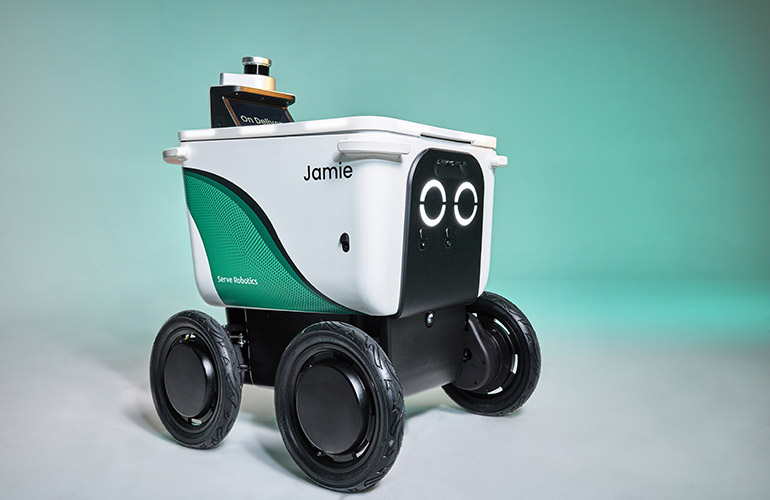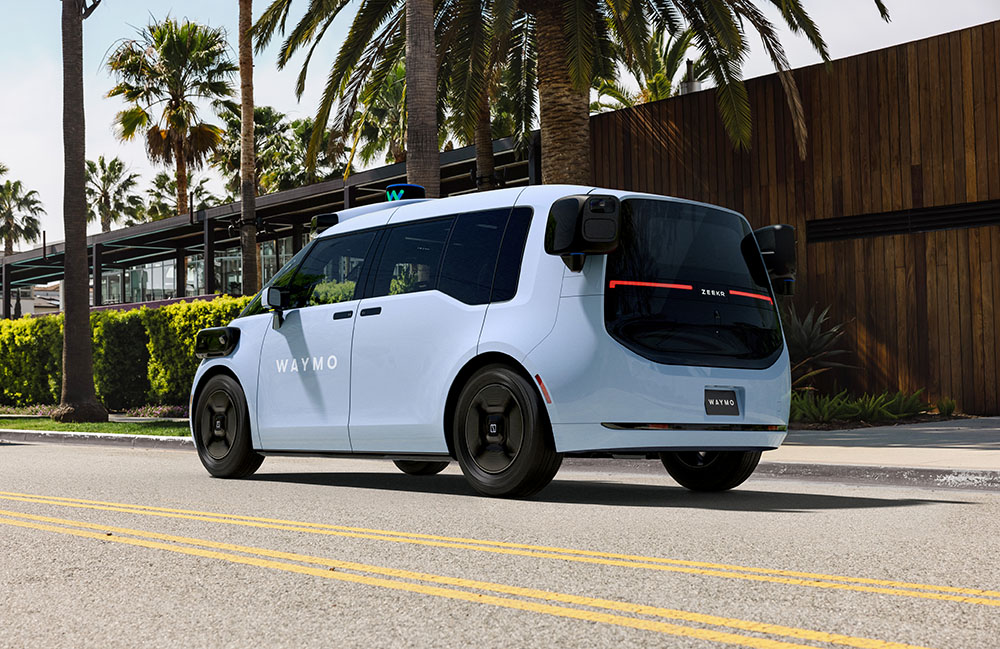The Intuitive da Vinci 5 (top left), Sony microsurgery assistance robot (top right), Stryker Mako (bottom left) and Globus Medical ExcelsiusGPS (bottom right) are all featured in the top surgical robotics stories of 2024 so far. | Images courtesy of the companies
Editor’s Note: This article was syndicated from The Robot Report’s sibling site MassDevice.
Surgical robotics has been a hot topic within the medtech space, and it doesn’t seem like it’s stopping any time soon.
Over the course of 2024, we’ve seen all kinds of stories across surgical robotics. From regulatory nods and product launches to recalls and warning letters, plus some M&A in between, the surgical robotics space has been active over the past nine months.
At DeviceTalks West, co-locatd with RoboBusiness, in Santa Clara, California, Oct. 16-17, a wide range of robotic technologies will be featured. (Learn more about the event and register at West.DeviceTalks.com.)
If you need a refresher, here’s a list of 10 surgical robotics companies you need to know, published back in February. (Note: As you’ll read below, a lot has happened since then.)
Ahead of DeviceTalks West, let’s take a look at the surgical robotics stories that have garnered MassDevice’s readers’ attention in 2024:
Globus Medical faces FDA warning letter over surgical robotics platform
In August, shares of Globus Medical took a hit after the FDA published a warning letter alleging violations at a Pennsylvania facility.
According to the FDA letter, the inspection centered around the company’s Excelsius GPS surgical robot and associated interbody spine and cranial modules. Excelsius GPS’ uses include locating anatomical structures and for the spatial positioning and orientation of an instrument holder or guide tube to be used by surgeons for navigating and/or guiding compatible surgical instruments in open or percutaneous procedures provided that the required fiducial markers and rigid patient anatomy can be identified on CT scans or fluoroscopy.
The FDA inspection revealed that the devices “are adulterated,” or not in conformity with current good manufacturing practice requirements. Specifically, the FDA found a failure to submit a report to the FDA no later than 30 calendar days after the firm received or otherwise became aware of information that reasonably suggested that the device in question may have caused or contributed to a death or serious injury.
Globus Medical issued a statement saying “we are confident that we have the data and documentation to support swift resolution in this matter.”
Intuitive details da Vinci 5 launch plans following FDA nod
Intuitive, the longtime leader in surgical robotics, further cemented its place atop the space with FDA clearance for its next-generation robot this year.
In March, the company won FDA 510(k) clearance for the da Vinci 5, adding it to a portfolio that features the multiport X and Xi systems and the single-port SP. The company also has Ion, its robotic-assisted platform for minimally invasive biopsy in the lung.
New features of the da Vinci 5 include updated surgeon controllers and powerful vibration and tremor controls, next-generation 3D display and image processing capabilities and Force Feedback technology, among other enhancements.
Shortly after picking up FDA clearance, company officials outlined their launch plans for the new robot. Intuitive expects its limited rollout to continue into 2025 to optimize manufacturing and supply chain ahead of a full launch. (Medical Design & Outsourcing explored what the da Vinci 5 launch plans could teach other device developers. And here’s more about the da Vinci 5’s design.)
Karl Storz acquires Asensus Surgical
Asensus, formerly TransEnterix, made waves in the surgical robotics space when it agreed to be acquired by Karl Storz in June for 35¢ per share in cash.
Following some scrutiny over a lack of disclosures, Research Triangle Park, North Carolina–based Asensus said it would file for bankruptcy protection if shareholders failed to approve the Karl Storz merger. However, in August, the company’s shareholders gave the green light for the deal to go ahead and the acquisition closed in August.
Karl Storz believes the deal enhances its portfolio and market presence within the surgical robotics space. The company particularly highlighted the ongoing development of Asensus Surgical’s next-generation Luna platform.
Asensus also develops the Senhance surgical robot platform. It also develops the Intelligent Surgical Unit (ISU) for Senhance. Asensus designed ISU as a real-time intraoperative surgical image analytics platform. It leverages augmented intelligence to help reduce surgical variability.
Medtronic advances its surgical robotics offerings
Medtech giant Medtronic continues to plug ahead with its Hugo surgical robot, a potential rival to da Vinci down the line. In May, the company announced the initiation of additional clinical studies for Hugo to expand its indications to hernia and gynecology.
The studies are underway to support a planned submission to the FDA for the Hugo system. Hugo, first unveiled in September 2019, is a modular, multi-quadrant platform designed for various surgical procedures with wristed instruments, 3D visualization and surgical video capture options in Touch Surgery Enterprise. It already has install bases growing across 25 countries outside the U.S.
In addition to the advancements for Hugo, Medtronic introduced its new Live Stream function for the Touch Surgery ecosystem of digital technologies in July. Touch Surgery Live Stream includes 14 new AI algorithms designed to enhance its digital capabilities within post-operative analysis. The algorithms deliver AI-powered surgical insights for laparoscopic and robotic-assisted surgery.
As the company pushes ahead in surgical robotics, it has a new figure helping to lead the effort. In September, the company announced that Dr. James Porter joined the company as chief medical officer of Robotic Surgical Technologies and Digital Technologies. Medtronic expects Porter to play a key role in driving focus on patients and robotic and digital innovation.
Medrobotics puts its surgical robotics assets up for sale
In May, Tiger Group and Liquidity Services announced the availability of all surgical robotics assets from a Medrobotics plant at auction.
They made available all assets from the company’s fully furnished, 40,000-square-foot plant in Raynham, Massachusetts. That included the purchase or lease of the building. Assets, including surgical robotics platforms used by nearly 30 hospitals around the world, were made available in a turnkey sale.
Medrobotics boasted an FDA-cleared, CE-marked surgical robotic platform for several years. The company designed its minimally invasive Flex system to access hard-to-reach anatomy for otolaryngology, colorectal and gastroenterology procedures.
However, the company hit a number of stumbling blocks over the past several years — including a significant IP case loss — leading to the sale of these assets.
Mendaera enhances its medical robotics offerings with the purchase of Avail’s technology
The Avail Medsystems telepresence console can beam video, audio and information to laptops and tablets. | Source: Avail Medsystems
Avail Medsystems, a company aiming to establish virtual connections between medical device sales reps and operating rooms, shut down last November due to lack of funding. In March, the now-shuttered company found a home for its technology.
Medical robotics startup Mendaera agreed to purchase the Avail technology and hired some of its employees. The deal included “substantially all” of Avail’s assets.
Avail’s system consisted of a 6-ft-high tower equipped with high-resolution cameras, monitor and sound that connected parties separated by feet, miles or oceans. The company’s cameras provided a crisp and clear view of surgical suites. The built-in speakers enabled seamless conversation between surgeons and outside parties working on a proprietary laptop interface.
In addition to the purchase of Avails’ assets, Mendaera continued its solid exit from stealth mode by closing a $73 million Series B financing round in September. Mendaera’s platform under development includes robotics, AI, real-time imaging and virtual connectivity. The company designed it for accessibility across specialties and sites, helping to meet the growing demand for needle-based interventions.
Johnson & Johnson to pay significant damages in Auris shareholder suit
A Delaware judge ruled in September that Johnson & Johnson must pay $1 billion in damages to Auris Health shareholders.
The ruling claimed that J&J breached its agreement to acquire Auris, which went through for $3.4 billion in February 2019. The deal also included up to an additional $2.35 billion in payments to shareholders based on various milestones.
J&J failed to have the suit dismissed in 2021, leading to a decision from Vice Chancellor Lori Will of the Delaware Court of Chancery. Will ruled that J&J breached the agreement and failed to support the acquired iPlatform technology. According to the report, this would have led to increased payments to Auris shareholders.
Reuters says Will’s ruling stated that J&J breached the agreement “almost immediately after closing.” The judge deemed that J&J declined to put resources toward advancing iPlatform and instead pitted it against its own Verb device that it developed in partnership with Google sibling company Verily.
According to Reuters, J&J said it disagrees with the ruling and is considering an appeal. The company also said this ruling has no bearing on its current robotics program, which includes the much-anticipated Ottava system. J&J remains on track to submit the Ottava surgical robot for FDA investigational device exemption (IDE) in the second half of this year. Meanwhile, the company’s DePuy Synthes unit launched an updated platform to enable the use of its Velys robot in spine procedures.
Sony wants a stake in the surgical robotics market
Sony developed a microsurgery assistance robot that is capable of automatic surgical instrument exchange and precision control. | Source: Sony
Sony put its hat in the surgical robotics ring, unveiling its microsurgery assistance robot in May.
The Tokyo-based company said its microsurgery assistance robot is capable of automatic surgical instrument exchange and precision control. It developed the robot to assist in microsurgical procedures by using a microscope to work on extremely small tissues, such as veins and nerves. The system tracks the movements of a surgeon’s hands and fingers using a highly sensitive control device. Movements are then replicated on a small surgical instrument that operates similarly to the movement of the human wrist.
According to the company, the system addresses practical challenges in conventional surgical assistant robotics, such as interruptions and delays caused by manually exchanging surgical instruments. Sony’s R&D team developed the system to allow for the automatic exchange of parts through miniaturization.
Sony’s researchers hope to use the robot assistant in a wide variety of surgical procedures.
Stryker continues to expand the Mako platform
About a year ago, Stryker suggested that the robotic platform would have significant application expansions in 2024. It said it expected a Mako Spine launch in the second half of 2024, with Mako Shoulder out by the end of 2024. Both launches have yet to commence ahead of the final three months of 2024, though.
Stryker also launched Mako Total Knee 2.0 in March 2023 and rolled out a direct-to-patient marketing campaign in August 2023.
This year, the company said it wants to extend a surgeon’s Mako SmartRobotics experience in and beyond the operating room. To execute this, it announced the myMako app for Apple Vision Pro and iPhone in February. When used on Apple Vision Pro, myMako allows surgeons to visualize and review patients’ Mako surgical plans anytime, anywhere.
The company calls the new innovation “a brilliant, immersive visual experience.” It marks the latest potential innovation for Mako, which the company expects to continue expanding as the year goes on.
Another Mako update comes in the form of the company’s direct anterior reconstructive technology (DART). Stryker aims to reduce intra-operative fluoroscopy in direct anterior hip replacement procedures. Mako SmartRobotics, as part of the DART ecosystem, demonstrated accuracy in surgical planning for total hip arthroplasty without the use of fluoroscopy.
Think Surgical inks countless collaborations for its surgical robotics platform
Fremont, California–based Think Surgical develops the TMINI system, which received FDA clearance in May 2023. TMINI features a wireless, robotic handpiece. It assists surgeons in performing total knee replacement.
In June, the company made perhaps its most noteworthy deal when it entered into a limited distribution agreement with Zimmer Biomet. Dr. Nitin Goyal, Zimmer Biomet’s chief science, technology and innovation officer, said at the time that the deal made the company the first to offer two complementary robotic systems for surgeons looking to incorporate robotic assistance while performing a knee replacement. (Zimmer Biomet also offers the flagship Rosa platform. Rosa, which recently expanded into shoulder replacement, has four applications, including the knee.)
The collaboration bore fruit in September, when the FDA cleared the miniature surgical robot for use with the orthopedic giant’s Personalized Knee System. Clearance makes Think Surgical the only company offering a robotic system providing both an implant-exclusive option with the Persona Knee system and an open implant platform for use with implants from multiple other manufacturers for total knee arthroplasty.
Think Surgical says it aims to offer surgical robots that support implants from multiple manufacturers. The Zimmer Biomet clearance follows FDA clearance for TMINI with Medacta knee systems in August, plus clearance for new software in July. The company has since added a number of implant options to its system. That includes collaborations with Maxx Orthopedics, b-ONE Ortho and Signature Orthopaedics.

 3 months ago
38
3 months ago
38




















 English (US) ·
English (US) ·